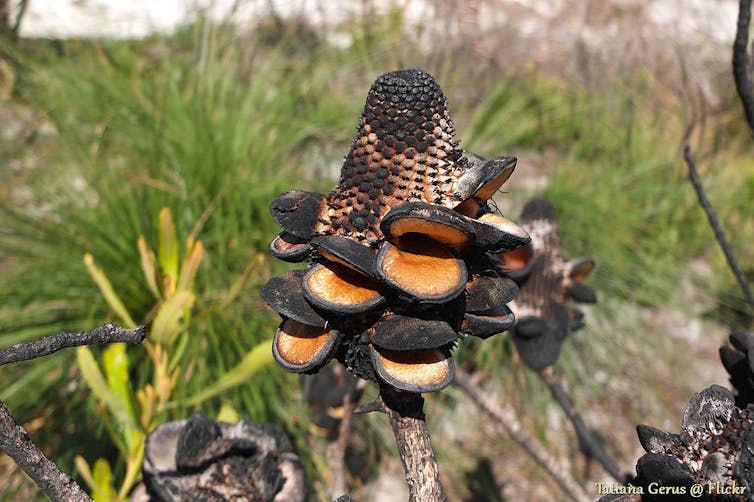Once the coat around the seed is moistened, the embryo cells expand and burst out in a process called germination. shutterstock/NUM LPPHOTO

Cris Brack, Australian National University
This is an article from Curious Kids, a new series for children. The Conversation is asking kids to send in questions they’d like an expert to answer. All questions are welcome – serious, weird or wacky!
How can a tiny seed actually grow into a huge tree? – Finney, aged 6, from Bairnsdale in rural Victoria.
Tree seeds fall (like the tiny Eucalypt seeds) or helicopter down (like the winged seeds of the Maple) from their parents with a full set of instructions on how to grow.
A single tree may drop hundreds or even many thousands of seeds. Many of these seeds will become snacks for insects or fall where the ground is too hard, too dry, or just not suitable for trees. Some though will fall where the situation is just right!
Just right might mean bare dirt or some nice decayed mulch with enough sunlight.
The seed contains an embryo - a group of cells ready to form roots, a stem and the first leaves. Once the coat around the seed is moistened, the embryo cells expand and burst out in a process called germination.
First, the roots will develop and push out and down into the soil to make sure the new plant can get water. Then the stem cells stretch up to display the first leaves.
The embryo uses food stored in the seed to power its initial growth until the leaves can start producing food. Small seeds don’t have much stored food so they have to fall in just the right spot to be successful. The parent tree has some ways to improve the chances of its seed finding the right spot, like dropping seeds after a bushfire has made the ground bare and free from other plants that would use all the water and nutrients.
Once the roots are in the soil and the first leaves are in the sun, the plant is ready to really start growing.
People stop growing after they’ve become grown-ups but trees just keep getting taller and thicker however long they are alive.
Grass, bamboo and many other plants grow from the bottom up, so if you put a mark on the stem and come back in a little while, that mark will have been pushed further above the ground. But if you put a mark or even nail a board into a tree at one metre above the ground then come back in 10 years, it will still be only one metre above the ground. That’s because trees grow from the outside and the top up.
The newest and outer shell of a tree contains all the living parts of the wood - the parts that move water up from the roots and food down from the leaves. If trees stop growing these outer, living shells of wood, the whole tree dies.
Some trees can grow to be more than 100 metres tall – that’s as tall as a skyscraper! In fact, humans are now building buildings out of wood that are over 50 metres tall and there are plans to go well beyond that.
The tallest tree currently is over 110 metres tall, and scientists think some trees may have been as much as 150 metres tall.
A problem with getting even taller is that trees use water the same as you use blood - to move the nutrients and oxygen and other vital things around our body. But a tall tree has to move it from the roots to the tip of the leaves. For a 100 metre tall tree, that is like 30 flights of stairs. And a big tree could use more than 200 litres of water every day. Imagine carrying 30 buckets of water up 30 flights of stairs every day!
In our tall buildings, we need huge pumps and generators to move the water to the top, but trees just rely on their amazing structure and a little bit of power from the Sun.
Hello, curious kids! Have you got a question you’d like an expert to answer? Ask an adult to send your question to us. They can:
* Email your question to curiouskids@theconversation.edu.au
* Tell us on Twitter by tagging @ConversationEDU with the hashtag #curiouskids, or
* Tell us on Facebook

Please tell us your name, age, and which city you live in. You can send an audio recording of your question too, if you want. Send as many questions as you like! We won’t be able to answer every question but we will do our best.![]()
Cris Brack, Assoc Professor Forest measurement & management, Australian National University
This article is republished from The Conversation under a Creative Commons license. Read the original article.








